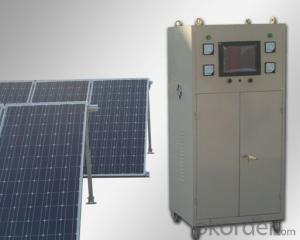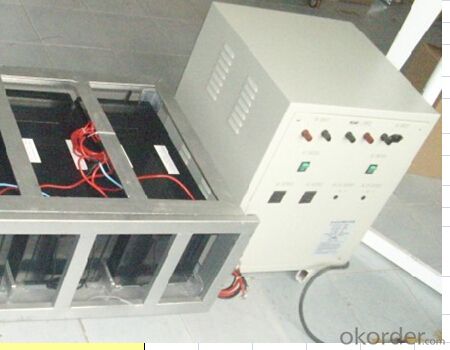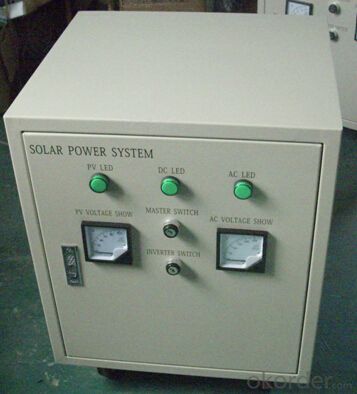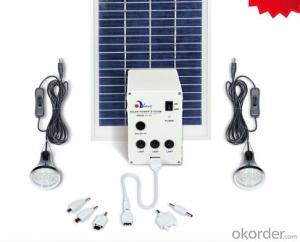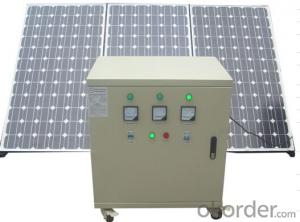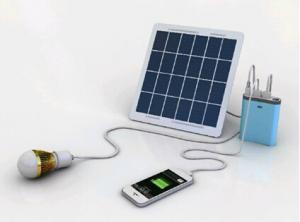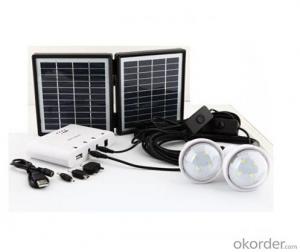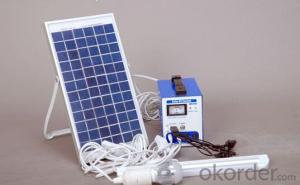Arc Solar Energy Systems CNBM 5000W Solar Home System Roof System Solar Energy
- Loading Port:
- Shanghai
- Payment Terms:
- TT or LC
- Min Order Qty:
- 1 pc
- Supply Capability:
- 30000 pc/month
OKorder Service Pledge
OKorder Financial Service
You Might Also Like
Working Principle of Solar Home System
The stand alone Solar Home System is an off-grid solar system which uses batteries to store the solar energy. Stand alone solar system solutions design for those who are not able or willing to connect to electricity grid.
However, our on-grid solar home system can be connected to the grid for utilization of grid electricity power. Our solar system can add relative equipment as our customer’s requirement which have the function of switching to city electricity automatically. The solar system can use battery power in priority, if sunshine is not so good or loads consumption is too high which cause battery power insufficient. Then system can switch automatically to grid power supply. Meanwhile, the system can charge the batteries with grid power until batteries are fully charged. Then the solar system will switch back to battery power supply.
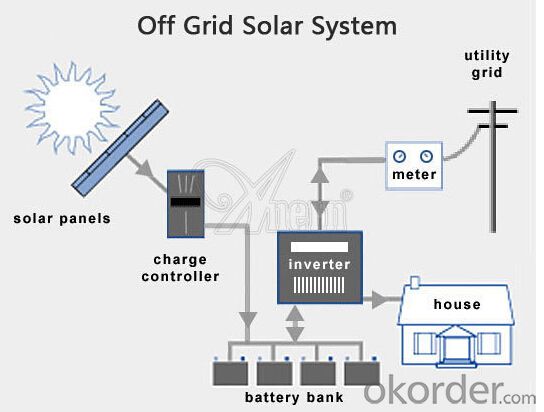
Product Details of Solar Home System
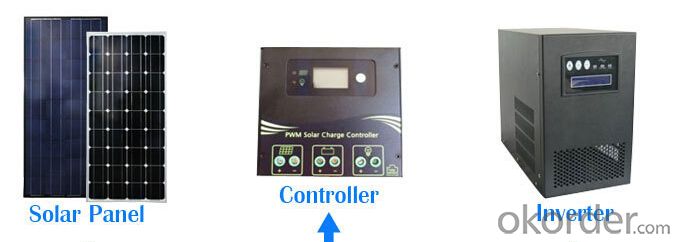
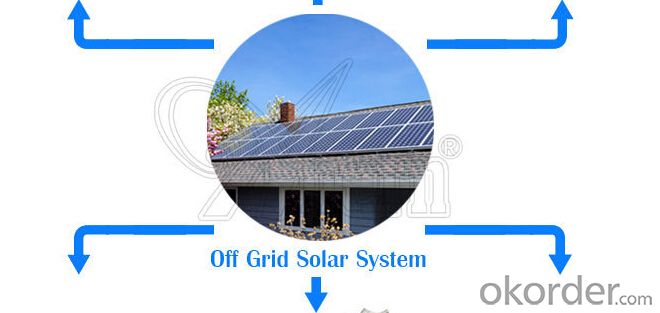

Specification of Solar Home System
Technical data: | ||||||||
Inverter | Rated load power | 5000W | ||||||
Output wave | Pure sine wave | |||||||
Input voltage | 110V | |||||||
Output voltage | DC:12V | |||||||
Output frequency | 50HZ/60HZ | |||||||
Precision of output frequency | ±6% | |||||||
Solar panel | Pmax | 180W*28PCS | ||||||
Vmp | 36V*4*7 | |||||||
Imp | 52.5A | |||||||
Charger controller | Charger voltage & current | 110V/60A | ||||||
Battery | Capacity | 12V/150AH*16PCS | ||||||
support | Aluminium | 4PCS/SET*7 | ||||||
Power box | Spray paint iron box,with input,output, ammeter,voltmeter,master switch and so on. | |||||||
Package data: | ||||||||
Part | Size (L*W*H mm) | Weight (kg) | 20' (pcs) | 40' (pcs) | ||||
Power box | 840*620*150 | 140 |
|
| ||||
Solar panel | 1610*830*100*(6ctns) | 180 | ||||||
Battery | 1100*520*650*2 | 1200 | ||||||
Loading electrical equipment(For consulting) | ||||||||
Name of Load | Power(W) | Quantity | Working Time per Day (H) | Working Days | ||||
Color TV | 65W | 2 | 6 | 3 days | ||||
Satellite TV Receivers | 25W | 2 | 6 | 3 days | ||||
lamp | 11W | 8 | 8 | 3 days | ||||
Computer | 150 W | 2 | 6 | 3 days | ||||
FAN | 60W | 4 | 6 | 3 days | ||||
Other | 3000W | 1 | 6 | 3 days | ||||
Advantage of Our Solar Home System
1 Excellent Performance: Our Solar Home System is composed by Brand Standard Kits with high quality. Our solar system has the advantage of high efficiency and stable operation. We can ensure our product with a long life period.
2. Small Orders Accepted: We can accept small orders as our customer’s trial order.
3. Warehouse: We have warehouse overseas which can bring great convenience to our customer to pick up the products.
- Q: Are there any risks of electrical grounding issues with solar energy systems?
- Solar energy systems can pose several risks due to electrical grounding issues. One major risk is the potential for electric shock, which occurs when the grounding system is not correctly installed or maintained. This can cause a buildup of electrical current, leading to contact with live electrical components and subsequent shock. Another risk is the possibility of fire. When the grounding system is improperly installed, it can result in electrical arcing, which can ignite a fire. This is especially hazardous as solar energy systems are often situated on rooftops, making it easier for a fire to rapidly spread throughout the entire building. Furthermore, a faulty grounding system can cause damage to the solar energy system itself. Without proper grounding, electrical surges and fluctuations can occur, harming sensitive components like inverters and batteries. To mitigate these risks, it is essential to ensure the proper installation and regular inspection and maintenance of the grounding system in a solar energy system. This involves using appropriate grounding equipment like grounding rods or conductors, as well as ensuring all connections are secure and free from corrosion. Regular testing should also be carried out to assess the effectiveness of the grounding system. It is advisable to enlist the services of a qualified professional for the installation and maintenance of the grounding system to minimize the hazards associated with electrical grounding issues in solar energy systems.
- Q: Can solar energy systems be installed on roadways?
- Yes, solar energy systems can be installed on roadways. Solar roadways, also known as solar panels or solar tiles installed on roads, have been developed to generate electricity from sunlight. These systems have the potential to harness solar energy and convert it into usable electricity, helping to power streetlights, traffic signals, and even nearby buildings. However, the practicality and efficiency of solar roadways are still being researched and tested.
- Q: Can solar energy systems be used for powering oil and gas extraction operations?
- Yes, solar energy systems can be used for powering oil and gas extraction operations. In fact, the use of solar energy in the oil and gas industry has been gaining traction in recent years. Solar power can be utilized to provide electricity for various operations such as pumping, drilling, and processing. It is particularly beneficial in remote areas where access to the grid may be limited or expensive. Solar energy systems can reduce the carbon footprint of oil and gas extraction operations by minimizing the reliance on fossil fuels for power generation. Additionally, solar power can lower operational costs in the long run, as it offers a more sustainable and cost-effective alternative to traditional energy sources.
- Q: What is the role of solar energy systems in reducing greenhouse gas emissions?
- Solar energy systems play a crucial role in reducing greenhouse gas emissions by harnessing the power of the sun to generate electricity without any emissions. They provide a clean and renewable alternative to fossil fuels, such as coal and natural gas, which are major contributors to greenhouse gas emissions. By utilizing solar energy, we can significantly decrease our reliance on these polluting sources, leading to a substantial reduction in greenhouse gas emissions and helping combat climate change.
- Q: What is the impact of shade from nearby buildings or trees on the performance of solar panels?
- The performance of solar panels is significantly affected by the shade caused by nearby buildings or trees. Even partial shading can greatly reduce their ability to generate electricity by decreasing the amount of sunlight reaching the panels. This shading can lead to a phenomenon called "panel mismatch," where some parts of the panel receive sunlight while others remain in shade. As a result, shaded cells produce less electricity than unshaded cells, resulting in an overall drop in panel performance. Additionally, shaded cells can create resistance, causing the other cells to work harder and potentially causing hotspots or damage. Furthermore, shade can disrupt the electrical flow within the panels, negatively impacting the entire solar power system. In series-connected panels, even one shaded cell can significantly reduce the output of the entire array, resulting in a substantial loss of power generation and affecting the return on investment and payback period. Considering the shading factor is crucial when designing and installing solar panels. Conducting shading analysis can reveal potential areas of shade throughout the day and year. By avoiding or mitigating shading, the performance and efficiency of solar panels can be optimized. There are various measures that can be taken to address shading issues, such as adjusting the tilt and orientation of the panels, trimming or removing nearby trees, or utilizing technologies like micro-inverters or power optimizers that minimize the impact of shade on the system. In conclusion, nearby buildings or trees causing shade have a significant impact on the performance and efficiency of solar panels, reducing their power generation potential. Considering shading factors during the design and installation process is crucial to maximize the benefits of solar energy.
- Q: Can solar energy systems be used in areas with high population density?
- Yes, solar energy systems can be used in areas with high population density. In fact, solar energy systems can be particularly beneficial in densely populated areas as they can be installed on rooftops, buildings, and other available spaces, making efficient use of limited land resources. Additionally, solar energy systems can help reduce reliance on traditional energy sources, decrease greenhouse gas emissions, and contribute to a cleaner and more sustainable environment for densely populated communities.
- Q: Can solar panels be installed on vertical surfaces?
- Yes, solar panels can be installed on vertical surfaces. While the most common and efficient installation method is to mount solar panels on rooftops or tilted surfaces facing the sun, there are also specialized solar panels designed specifically for vertical installations. These panels, known as vertical or facade solar panels, are typically designed with a frameless and lightweight design to be easily mounted on vertical surfaces like walls or building facades. Vertical solar panels can be a great solution for buildings with limited roof space or for those looking to maximize energy production on all available surfaces. However, it's important to note that vertical installations may not be as efficient as traditional rooftop installations due to the reduced exposure to sunlight. The angle and orientation of the surface, as well as potential shading from nearby structures or trees, can also impact the performance of vertical solar panels. Nevertheless, advancements in solar technology and design have made vertical installations more viable and efficient than ever before. With proper planning and consideration of factors like surface tilt, orientation, and shading, solar panels can be successfully installed on vertical surfaces to harness clean and renewable energy.
- Q: Can solar energy systems be used for powering remote communication systems?
- Yes, solar energy systems can be used for powering remote communication systems. Solar panels can be installed in remote areas to capture sunlight and convert it into electricity. This electricity can then be used to power various communication systems, such as satellite phones, radio transmitters, or remote monitoring devices. Solar energy offers a sustainable and reliable solution for powering communication systems in remote locations where traditional power sources may not be available or feasible.
- Q: Can solar energy systems be installed on floating structures?
- Yes, solar energy systems can be installed on floating structures. Floating solar, also known as floating photovoltaic (FPV) or floating solar power plants, involves the installation of solar panels on floating platforms such as lakes, reservoirs, or oceans. This innovative approach offers several advantages, including increased energy production due to the cooling effect of water, reduced land usage, and the potential to utilize otherwise unused bodies of water for renewable energy generation. Floating solar systems have been successfully implemented in various countries and are becoming an increasingly popular and viable option for harnessing solar energy.
- Q: Can solar energy systems be easily expanded or upgraded?
- Solar energy systems can be expanded or upgraded with ease. One of the key benefits of solar technology lies in its modular design, which allows for scalability and flexibility. If you have extra space, you can effortlessly increase the capacity of your system by adding more solar panels. Moreover, advancements in solar technology have simplified the integration of new panels into existing systems. To upgrade a solar energy system, one can replace older or less efficient components with newer and more efficient ones. For instance, higher capacity inverters or battery storage can be added for energy storage purposes. The ability to expand and upgrade solar energy systems makes them a cost-effective and sustainable solution for meeting growing energy demands over time.
Send your message to us
Arc Solar Energy Systems CNBM 5000W Solar Home System Roof System Solar Energy
- Loading Port:
- Shanghai
- Payment Terms:
- TT or LC
- Min Order Qty:
- 1 pc
- Supply Capability:
- 30000 pc/month
OKorder Service Pledge
OKorder Financial Service
Similar products
Hot products
Hot Searches
Related keywords
